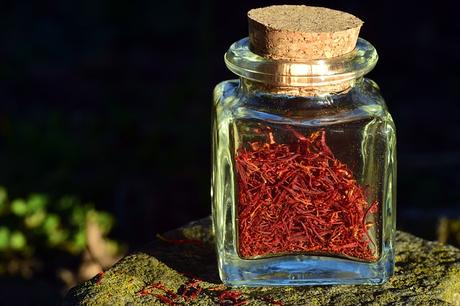
What is it?
Scientific name: Crocus Sativus
Family: Iridaceae
Saffron is a spice that is very common in the Mediterranean cuisine. The spice is actually the stigma of the saffron flower. It has many benefits for your health. Saffron is great source of antioxidants, has relaxing properties and can even stimulate digestion. Here’s why saffron is a great addition your spice cabinet.
The Health Benefits of Saffron Include:
High Antioxidant Content
Used for millennia in traditional medicines, saffron has many medicinal properties, including an incredibly high antioxidant content. It’s the carotenoids contained in saffron that provide these powerful antioxidants. Recent studies would even indicate a possible correlation between the use of saffron and the fight against certain types of cancer.
It has relaxing properties
Saffron also has calming effects thanks to its substantial magnesium content. Magnesium is a necessary nutrient to the body that facilitates many functions. It reduces cramps, but also has a beneficial effect on the prevention of cardiovascular diseases as well as type 2 diabetes. In clinical trials, Saffron has proven to have a positive effect on sleep. Saffron helps you fall asleep faster, stay asleep longer and wake up feeling more refreshed. Saffron is also well known for
alleviating depression
as seen in clinical trials. It’s often prepared as a tea for improving mood.
Promotes Proper Digestion
When consumed in small doses and infused as a tea, saffron stimulates and encourages good digestive activity by stimulating the liver. It also reduces the side effects of alcohol consumption. A study included in the US National Library of medicine concluded that crocetin, an active component in saffron, reduces the risk of alcohol- related disease
Saffron Is a Great Analgesic
The safranal contained in saffron acts as an analgesic on the nervous system. It can be used to reduce gum pain, but also could reduce menstrual pain and the back pain that is often associated with it.
Nutritional values of saffron
Nutritional value for 1 tbsp (2.1 g)
Carbohydrates1.37 g
Dietary fibre0.10 g
Total Fat0.12 g
Saturated 0.03 g
Trans 0.00 g
Monounsaturated 0.01 g
Polyunsaturated 0.04 g
Protein0.24 g
VitaminsQuantity %DV†
Vitamin A11 IU
Riboflavin (B2)1% 0.01 mg
Niacin (B3)0% 0.03 mg
Vitamin B62% 0.02 mg
Folate (B9)1% 2 μg
Vitamin C2% 1.7 mg
MineralsQuantity %DV†
Calcium0% 2 mg
Copper1% 0.01 mg
Iron2% 0.23 mg
Magnesium2% 6 mg
Manganese29% 0.6 mg
Phosphorus1% 5 mg
Potassium1% 36 mg
Selenium0% 0.1 μg
Sodium0% 3 mg
Zinc0% 0.02 mg
Other constituents
Water 0.25 g
Kaempferol4.3 mg
Ash0.11 g
Iron
The iron contained in saffron will promote the transport of oxygen in the body and help the formation of hemoglobin.
Magnesium
The magnesium is found in large quantities in saffron and will act as a good myorelaxant, so its use will be advisable if you want to reduce cramps and muscular pains. Its soothing effect will be effective to also promote a higher quality sleep.
Manganese
Manganese will allow for a better absorption of iron, but will also strengthen the natural body defenses, including the liver.
Beta carotene
The richness of beta-carotenes (or carotenoids) in saffron will play a very important antioxidant role. It will help fight against cellular aging and could also have an anti-cancer effect.
Vitamin B6
Its presence will help in the synthesis of insulin, and plays a role in the prevention of type 2 diabetes.
Using saffron in the kitchen
The taste of saffron
Saffron has a floral semi sweet slightly bitter taste that can vary depending on the country of origin of the spice. You can find notes of honey and a little mushroomy or even musky aftertaste.
How to choose saffron?
Above all, prefer saffron filaments rather than ground. Also make sure that the smell is close to that of hay, and that its color is a beautiful deep bright red. Yellow saffron powder is often ground saffron mixed with other spices of lesser quality.
How to store saffron properly?
As with most spices, saffron will be preserved better in its original case and kept away from light and moisture. The case must be well sealed, to prevent it from fanning and losing its flavor.
How to Cook With Saffron?
Remember to grind your saffron if you bought it in filaments. Add the saffron halfway through cooking, so that it has time to develop and release its flavors without mitigating them with too long cooking.
Saffron will give a very yellow color to your dishes. You can use it to prepare a paella, a French bouillabaisse or the famous Milanese risotto. It goes very well with fish dishes, seafood and with rice in general. It is often combined with other spices in the ” ras el hanout ” spice mix, which is an essential addition of couscous.
A little about the history of saffron
Originating from the Mediterranean basin of Europe, and widespread in many traditional medicines, many beneficial qualities have been attributed to saffron over the centuries. It has been widely used as a spice to season dishes, but also as a perfume and as a valuable medicine depending on the country.
Saffron is obtained by dehydrating the stigmas of the flowers of Crocus Sativus. It is a very meticulous procedure. The difficult extraction of saffron and the large number of saffron flowers necessary to obtain a quantity usable in the kitchen (150,000 flowers are needed to produce 1 kg) makes it one of the most expensive spices in the world.
